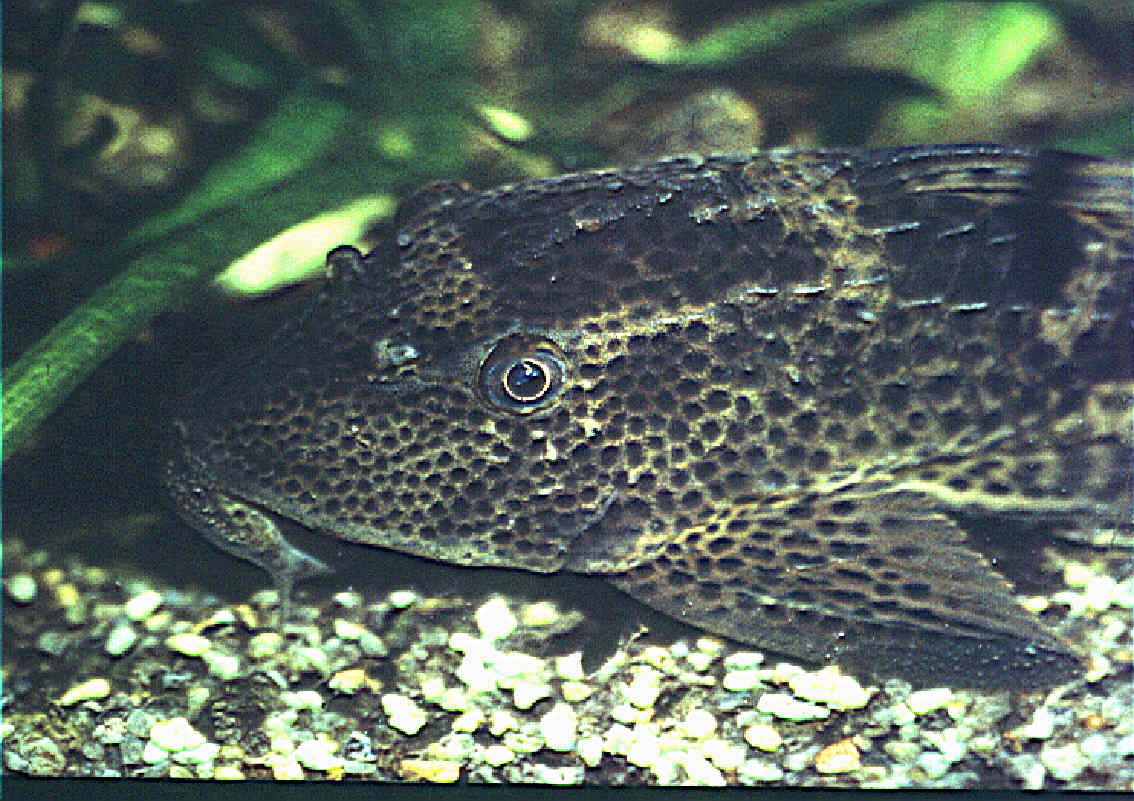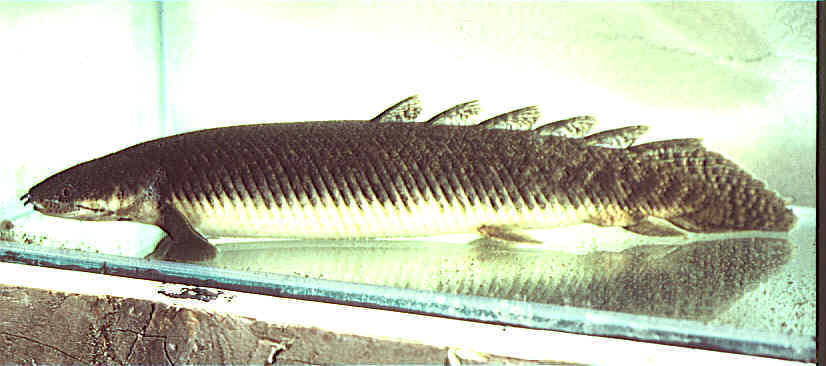



 Part of our fascination for fish comes from their amazing diversity, brought about by the need to survive and
adapt in a huge range of environments. The ability to breathe air is one such adaptation, which has allowed a vast array of fish to survive and thrive in habitats that would simply not support other species. Many commonly-kept aquarium species have this ability, and so it is of interest to look at the biology of air-breathing.
Part of our fascination for fish comes from their amazing diversity, brought about by the need to survive and
adapt in a huge range of environments. The ability to breathe air is one such adaptation, which has allowed a vast array of fish to survive and thrive in habitats that would simply not support other species. Many commonly-kept aquarium species have this ability, and so it is of interest to look at the biology of air-breathing.Evolution of Air Breathing
Air breathing has evolved in a large number of different fish species, thanks primarily to the limited abundance of oxygen in water. Compared to air, water may hold from 35 to 42 times less oxygen, and in addition it is far more energy consuming to extract it from water. This is because of the high viscosity and density of water when compared to air, making it harder to pass it across the gills. For this reason, oxygen has a far greater influence on the lives of fish than terrestrial animals.
Because of the limitations on oxygen availability in water, there is a very real danger that levels may become dangerously low, or even life-threatening. Where such conditions occur regularly, fish have had the opportunity to evolve to cope with them. Whilst not all have developed the ability to breathe air (for example, Carp have instead evolved the physiology to withstand short. periods of very low oxygen), many have gone down this route. The most common environment in which air breathing has evolved (in freshwater species), is in tropical swamps and pools that either experience seasonal or daily periods of low oxygen.
Many tropical waters are subject to seasonal drying, which concentrates large numbers of fish in a small volume of water. This increases the oxygen demand substantially, and in addition the resulting smaller volume of water tends to heat up quickly, further depressing oxygen levels. Other swamps and pools may be subject to nightly drops in oxygen levels, due to the abundance of aquatic vegetation and algae. Of the vast majority of freshwater species, routine falls in oxygen levels seem to be the primary force that has driven the evolution of air-breathing.
Types of Air-Breathing
Because air-breathing has evolved in so many families of fish (49, 32 of which are freshwater), there are not surprisingly a number of variations on the theme.
Air-breathing can be broken down into two main categories:
'amphibious' and 'aquatic'.
Amphibious air-breathing is that carried out by fish on land, such as Mudskippers. Although the occurrence of amphibious air-breathing in true freshwater fish is limited, there are examples such as the African Lungfish (during aestivation), and Clarias catfish during their overland migrations to find new habitats. However, the latter two only indulge in this type of air-breathing when forced, and do not voluntarily exit the water as part of their routine behaviour.
More common in freshwater fish is aquatic air-breathing, i.e. the taking of atmospheric air while the fish is in the water, usually by gulping it at the surface. Aquatic air-breathing can further be subdivided into 'facultative' and 'obligatory'. Facultative air breathers, such as Bristle-nosed Plecs, only breathe air when they need to, in response to falling oxygen levels. Continuous air-breathers generally breathe air all the time, although the regularity of it varies. Continuous air breathers may be 'obligatory', i.e. must have access to atmospheric air to survive (such as Trichogaster trichopterus), or 'non-obligatory', i.e. can survive if denied access (such as Corydoras spp).
Air Breathing Organs
Very few air-breathing fish use their gills to extract air from the atmosphere, and indeed having a large gill area can impede survival on land, or in heavily de-oxygenated water. This is because as well as diffusing in through the gills, oxygen may also diffuse out of them. In fish that inhabit very poorly oxygenated water, this would be a distinct disadvantage, as much of the oxygen in their blood may be lost. Depending on the extent to which they rely on air-breathing, many such fish have lost much of the gill area, to reduce this problem. In such species, the excretion of ammonia may also be affected, with a greater proportion of it being converted to urea. This is particularly well developed in those fish that spend time out of the water, where ammonia excretion would be impossible. To prevent levels building up and becoming toxic, they convert it to relatively harmless urea which can be stored for excretion later on. Air breathing organs (ABOs) are varied in their structure and position. Wherever they are, they usually consist of a highly vascularised 'respiratory epithelium', which is specially developed for the absorption of oxygen from air.
The most primitive forms of ABO include the lungs of Lungfish and Bichirs, and modified gas bladders, as seen in Garfish and Butterfly Fish. Other species have modified areas of the stomach, intestine, buccal and pharyngeal cavities, or even specific organs such as the 'labyrinth' in Gouramis, and the 'arborescent' organ in Walking Catfish.
Popular Air Breathers
There are a number of popular and well known ornamental species that breathe air, including the following:
Lungfish: Although not commonly kept, Lungfish are very well known in the aquarium hobby. They are probably the best known air-breathing fish, having lungs specially evolved for the purpose. Of the Lungfishes, the African (Protopterus spp) and South American (Lepidosiren paradoxa) species are the most reliant on air-breathing, and must do so to survive. Their ability to breathe air is so well developed that they can survive in cocoons during the dry season for years at a time (in a state called 'aestivation'). The Australian Lungfish (Neoceratodus forsteri) is not so reliant on air-breathing, having only one lung and being a facultative air-breather.
 Bichirs: Representatives of the African Bichirs are kept in captivity, and make fascinating pets when
cared for properly. They, like the Lungfish, use lungs to breathe air, and are the only known air breathing fish to practice 'recoil aspiration'. This involves the use of the muscles surrounding the lung to contract it, forcing used air out. As the muscles relax, new air is drawn in through the spiracles to the lungs. Many scientists believe that recoil aspiration formed the basis for the evolution of breathing in humans.
Bichirs: Representatives of the African Bichirs are kept in captivity, and make fascinating pets when
cared for properly. They, like the Lungfish, use lungs to breathe air, and are the only known air breathing fish to practice 'recoil aspiration'. This involves the use of the muscles surrounding the lung to contract it, forcing used air out. As the muscles relax, new air is drawn in through the spiracles to the lungs. Many scientists believe that recoil aspiration formed the basis for the evolution of breathing in humans.
Notopteridae: This family of fish includes the popular African Knife Fish, Xenomystus nigri, and the Clown Knife Fish, Notopterus chitala. They are both continuous air-breathers, and use their gas bladders as an ABO. Scientific studies have shown their ability to withstand anoxic water (no oxygen) for long periods. Under normal conditions, Clown Knife Fish will take air every 6 to 8 minutes.
 The Butterfly Fish: Pantodon bucholzi occurs in small pools, ditches, and backwaters in Africa, and is often seen for sale in aquatics outlets. An obligatory air breather, it must be given access to a warm layer of air above the tank. It uses its gas bladder as an ABO, and it relies heavily on air- breathing to meet its oxygen demand.
The Butterfly Fish: Pantodon bucholzi occurs in small pools, ditches, and backwaters in Africa, and is often seen for sale in aquatics outlets. An obligatory air breather, it must be given access to a warm layer of air above the tank. It uses its gas bladder as an ABO, and it relies heavily on air- breathing to meet its oxygen demand.
Weather Loach: Fish of the genus Misgurnus have a modified portion of the intestine that they use for extracting oxygen from air. As new air is gulped in, old air is forced out of the vent, giving the impression that they have 'wind'. They are obligatory air-breathers, and as such must be given access to air. Interestingly, they are one of the few freshwater air-breathers that don't come from tropical regions.
 Callichthyidae: This family of armoured catfish includes the popular Corydoras and Hoplosternum catfish. In species studied, up to 80% of the intestine may be modified for air-breathing, in a similar manner to the Weather loach. It appears that Corydoras aeneus (and therefore possibly other Corydoras) are facultative air-breathers, whereas Hoplosternum littorale is obligatory.
A shoal of Corydoras will often come to the surface in quick succession to take air, in a behaviour known as 'synchronous air-breathing'. This is seen in many other air-breathers, and is designed to minimise the chance of predation during risky migrations to the surface.
Callichthyidae: This family of armoured catfish includes the popular Corydoras and Hoplosternum catfish. In species studied, up to 80% of the intestine may be modified for air-breathing, in a similar manner to the Weather loach. It appears that Corydoras aeneus (and therefore possibly other Corydoras) are facultative air-breathers, whereas Hoplosternum littorale is obligatory.
A shoal of Corydoras will often come to the surface in quick succession to take air, in a behaviour known as 'synchronous air-breathing'. This is seen in many other air-breathers, and is designed to minimise the chance of predation during risky migrations to the surface.
Loricariidae: While not all Plecostomus breathe air, a number of commonly kept ones certainly do. Both Ancistrus and Hypostomus have been shown to take air, using their stomachs as ABOs. Old air is exhaled via the gill chambers, before new air is gulped in. Around 20 species have been shown to breathe air, and they all appear to be facultative, only doing so when necessary.
 Anabantoidei: Also called 'labyrinth' fish, this group of fishes are renowned for their air breathing abilities, and include popular species such as Trichogaster trichopterus, Colisa spp, Betta splendens, Ctenopoma spp, and so on.
Anabantoidei: Also called 'labyrinth' fish, this group of fishes are renowned for their air breathing abilities, and include popular species such as Trichogaster trichopterus, Colisa spp, Betta splendens, Ctenopoma spp, and so on.
The labyrinth organ is a specially modified structure, situated to the rear of, and just above the gills. The labyrinth is an intricate, bony structure, covered in a respiratory epithelium. It can be sealed off from the rest of the mouth, allowing normal feeding to carry on while oxygen is extracted from the air within it. All labyrinth fish are continuous airbreathers, and most are obligatory , making the provision of a warm layer of air essential.
Air-breathing is just one of the many fascinating aspects of fish behaviour that can be observed in an aquarium, and which make fish such remarkable animals.
Further reading: Air Breathing Fishes, Evolution, Diversity, and Adaptation. J. B. Graham, 1997. Published by Academic Press.
Last updated January 2005